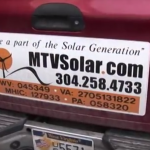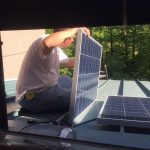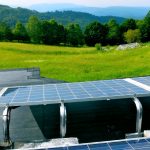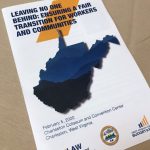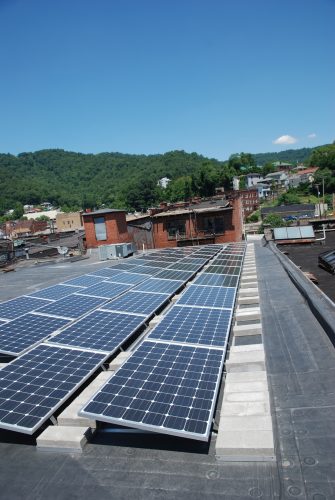
Today, much of the 1930s infrastructure has survived. Williamson, the Mingo County seat, still has the railroad, and the coal industry, but the county population has shrunk to a third of what it was in 1930, and it’s a trend that isn’t stopping. The population decreased five percent in the last ten years alone. Worse, too little of the billion dollars has remained at home. Nearly 27% of residents live in poverty, including 34% of the children.
“There’s a fixation about calling out what the problem is instead of fixing it,” says Eric Mathis, President of The JOBS Project. The JOBS Project, along with other local partners, has created a new approach to economic development called Sustainable Williamson, a comprehensive effort to make Williamson one of the most healthy, green, and economically viable cities in central Appalachia. If this model finds success in West Virginia, it can then be replicated throughout struggling mountain communities in Virginia, Kentucky, and Tennessee. For Mathis, an always-smiling man, it’s not enough for Williamson to return to where it was in its heyday. It should set the example the rest of the nation follows.
He is not alone. “The reason this town exists is because of the coal companies,” says Mayor Darrin McCormick. If America’s current energy system was built on the backs of Appalachian communities, he reasons, why can’t the next one be? “What better place for it to happen than here, a city that’s already been a leader?”
To call Sustainable Williamson an environmental project or a jobs project or a health project misses the point because it assumes they are different things. In truth, they are inextricably intertwined.
“If you approached this with a narrow scope, that would be a problem,” says Dino Beckett, a local doctor who worked with The JOBS Project to open a free health clinic for Williamson’s uninsured and underinsured. “If you just did health, just did jobs, just did the environment, it wouldn’t work. All things are synergistic.” Access to good doctors at affordable prices is an economic issue almost as much as it is a health issue. The response [to the free clinic] was ecstatic,” Dr. Beckett says. He points out that it fulfills a need in an area where unemployment is higher and health insurance coverage is lower than the national average. “It opens a lot of access posts and serves the underserved.”
More than that, he sees the clinic as a place people can learn about how to keep their health care costs down. It can be as simple as reminding people about the need to walk daily and eat well. He mentions how the county ranks in the top three nationwide in obesity and tobacco use. “When you’re dead last or next to dead last, you have to shake things up.” He’s quick to mention that good habits can spread just as quickly as bad habits. “If you’re cooking your meals, your kids see you preparing your food. They learn from that example. Williamson in the ‘40s had fruit stands, walking trails, good home cooked meals. If it’s easier to pick up fresh fruits and vegetables, if you’re reminded you need to exercise, then you will. If it’s in your face, you’re going to have to go out of your way to ignore it.”
But access to healthy food can be a problem. In rural communities, the closest and cheapest food is often the least healthy. This is why Sustainable Williamson is implementing a downtown farmers’ market in the shadow of the station where the coal train used to stop. On top of providing healthy, locally grown food, the farmers’ market acts as an economic boon for the food providers. “Our first market, we had a vendor who made eight hundred dollars,” says Zach Beckett of the Williamson Redevelopment Authority. Moreover, it provides economic stimulus to the city. “Using a farmers’ market gives a reason for people to come back downtown,” says Mayor McCormick. “That means they spend money locally, helping us all out.”
By helping the economy, Sustainable Williamson can also help the city’s infrastructure. For example, The JOBS Project is assisting in making the local fire department more sustainable. The City of Williamson has hired local contractors to install new lighting, new ceiling tile and a new heating and AC system. “The reason we jumped on this was to save money,” says Fire Chief Jerry Mounts. “If you can find a way to cut your heating and cooling bills, that’s another dollar the city can spend on filling pot holes, on infrastructure.” The fire department in Williamson is somewhat idiosyncratic, in that it has the world’s second longest fire pole (The building was built with three stories to accommodate the pole). Chief Mounts, a Williamson native, is proud the improvements can come locally. “This is where I live, buddy, and I love it here,” he says. “We know everybody. One of us gets down, everybody rallies around them.”
The fact that the improvements are made with local labor is not an accident. “We encourage hiring local talent,” Mathis says. “If we can’t find somebody local, we’ll get somebody here to train the locals.” Mathis emphasizes the importance of training to create as many local businesses as possible, even if it means training your competitors. “Competition is important for building a healthy market that will ensure the region’s future development of renewable energy resources.”
For instance, The JOBS Project persuaded Mountain View Solar from Berkeley Springs, WV, to train Mathew Gilliam, a local third generation electrician, in how to install solar panels. They then hired him to install solar panels on Dr. Dino Beckett’s office. Gilliam was happy to learn the new skill, calling solar energy “a coming thing in the world of energy.” He had been interested in solar energy for a while and took this opportunity to start his own solar company. “There’s quite a market for solar in this area. Everybody hates getting that big power bill.”
Gilliam’s partner, Murphy Poindexter, a West Virginian who spent three years working in solar power in Japan, points to other examples throughout the rest of the world. “Germany is the largest and most successful solar market in the world and West Virginia on average has 30% more sunlight.” Poindexter sees some areas making the same missteps in putting solar up that Japan did, and he wants to help West Virginia avoid making those mistakes. “Some states just give a ton of money and say, ‘Put solar up.’ This gives them no guidelines or standards for quality performance.” Japan, he said, dumped money into solar, but didn’t put proper regulations into it as well. “You could sell panels to someone on the north side of their house, which only works 65% as well as it should. If we do that here, people will think, ‘We tried solar and it didn’t work.’ West Virginians don’t forget.” If, however, Appalachian solar companies learn from the mistakes of other countries, then, “In five years, West Virginia could have as much solar energy as any leading market. We want to respect the legacy of natural resources in our state while bringing in a new solar business that just adds to the economy at large, bridging the gap between coal and solar.”
One of the main challenges Sustainable Williamson faces is that people assume it is a political project. “All we want to create is an economy of ideas,” Mathis says. “Some environmentalists want to create a dichotomy – ‘renewable energy is a liberal idea.’ But why?” Mathis is trying to debunk the perception that the fight for sustainability, health, and jobs has to be a liberal or conservative issue.
If people see sustainability as a political issue, he says, then some will shut down completely, others will embrace it reflexively, and no one will examine its merits. Sustainable Williamson believes the solutions are complex and the problems are far-reaching, but the reward is an Appalachia that is the envy of the nation, the heart of another billion-dollar industry.
—OO—
Read this article on the Daily Yonder.
Reprinting this article or content with attribution is encouraged. Contact Mimi Pickering, mpickering at appalshop.org, 606 633-0108, for more information on publishing and high resolution photos. A Word Document of the story is attached.
This work is licensed under a Creative Commons Attribution 3.0 Unported License.


